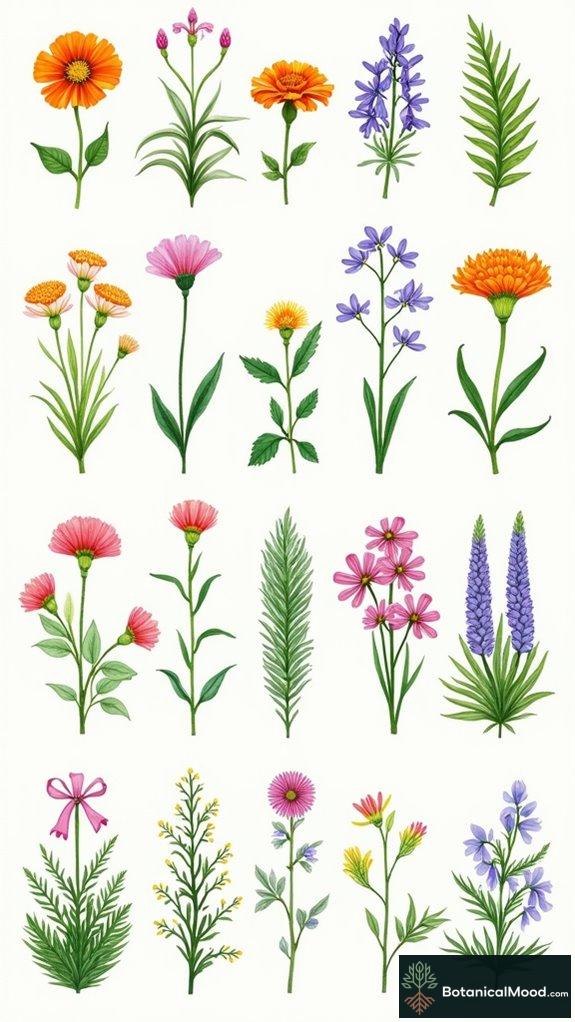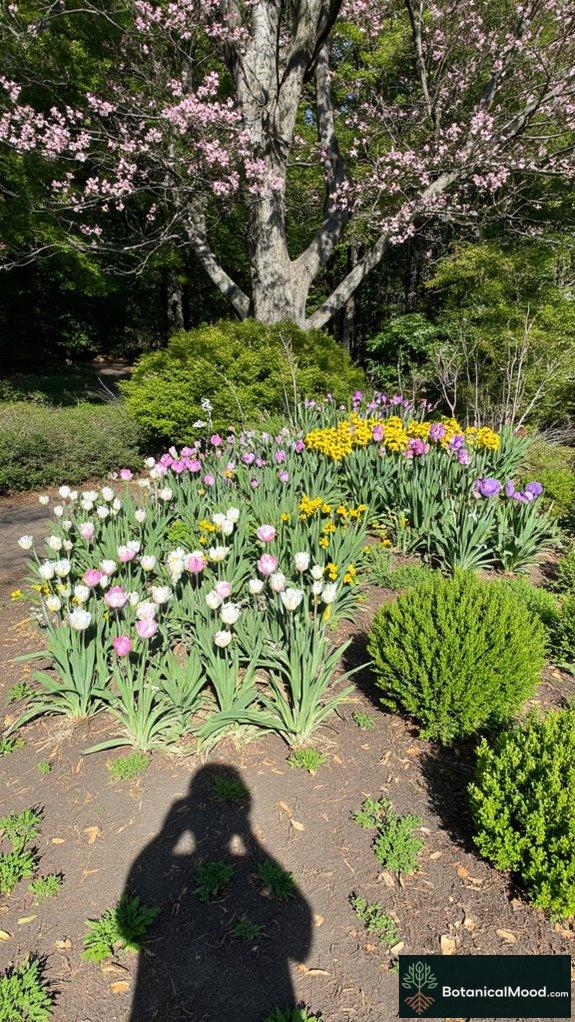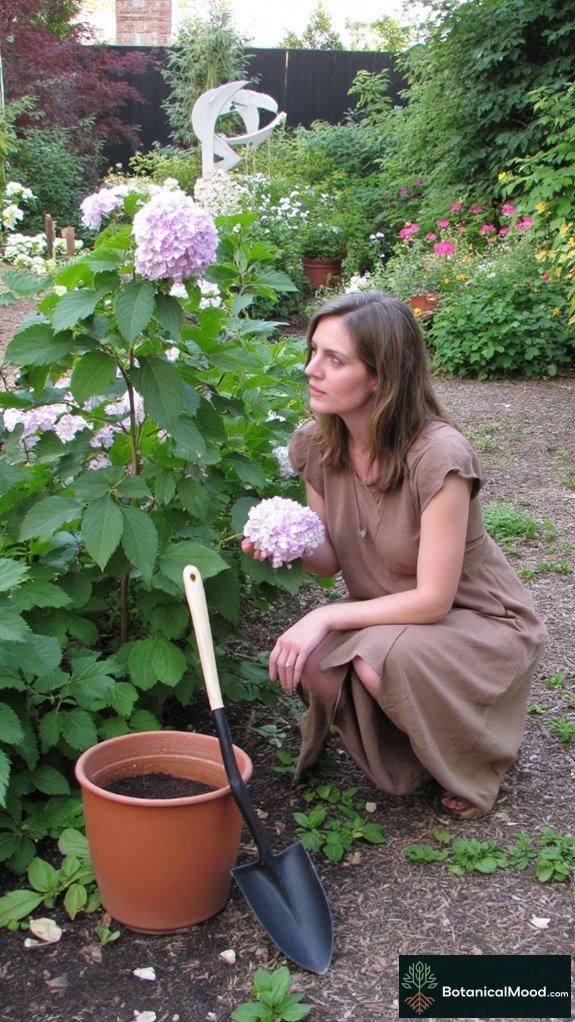Creating a garden that sings with color is no small feat—trust me, I’ve tried it.
It starts with the delicate dance of warm and cool hues. Picture this: I planted zinnias next to sweet peas, only to realize the lighting was all wrong. I felt like a colorblind painter—yikes!
Choosing a simple palette helps. Ever heard of color blocking? I’ve got my Fiskars tools, which remind me that every detail counts—even when I’m stuck outside wondering why my plants look more like a sad salad than a vibrant garden.
But hey, we live and learn, right?
The Art of Inconsistent Colors: A Garden Diary
I remember my first spring planting spree. Eager, I threw a hodgepodge of colors in the ground, convinced I was the next garden Picasso. The uncoordinated chaos was staggering. A garden, I realized, needs flow and purpose.
As I learned, choosing a seasonal palette is essential. Embracing repetition with striking colors can create a stunning visual experience. For me, combining seasonal elements like robust daffodils with soft lavender hues totally transformed my space. The thrill of watching blooms unfold, despite my initial misfires, taught me that every journey has its rough patches—and brighter blooms await those who stick with it!
Quick Takeaways
- Use a limited color palette to create cohesion and harmony, ensuring a flowing design that complements seasonal changes.
- Apply the 80:20 Rule to blend diverse plant species while maintaining vibrant color contrasts throughout the seasons.
- Select plants based on seasonal bloom times to achieve dynamic interest and visual continuity from early spring to late fall.
- Leverage the quality of seasonal light to enhance color vibrancy, choosing blooms that respond beautifully to changing light temperatures.
- Incorporate pathways and focal points in design to guide the eye and create structured yet flowing transitions between colored zones.
Understanding Warm and Cool Color Usage

When it comes to color in garden design, understanding the nuances of warm and cool hues can be a game changer.
By mastering color theory, I’ve learned that incorporating warm tones, like vibrant reds and oranges, ignites passion and energy in the scenery, while cool shades, such as serene blues and greens, foster tranquility.
Mastering color theory reveals how warm tones spark energy while cool shades cultivate tranquility in our garden spaces.
This balance creates visual harmony that enhances emotional effects.
Consider the psychological impact of seasonal shifts—those color choices reflect the essence of the time.
A well-curated palette can’t only beautify but also invigorate our garden spaces and elevate our daily experiences, reminding us why I created Botanical Mood.
Simplifying Color Choices for Harmony

How can we simplify our color choices while still achieving a harmonious garden design? I find that employing a few selection strategies can make all the difference in showcasing color harmony. By focusing on a limited palette, you’ll create a cohesive and inviting atmosphere. One effective method is to use color blocking techniques that enhance both structure and aesthetics in your garden.
Below is a streamlined approach:
| Primary Colors | Accent Colors | Plants Example |
|---|---|---|
| Blue | Yellow | Hydrangea, Coreopsis |
| Red | White | Roses, Phlox |
| Yellow | Purple | Marigolds, Asters |
| Green | Orange | Ferns, Daylilies |
This structured approach simplifies choices, ensuring vibrant connectivity in the garden’s design.
The Importance of Color Repetition

Though many aspects contribute to an enchanting garden design, color repetition stands out as an essential technique for enhancing visual coherence and emotional impact.
It fosters color harmony, creating a rhythmic flow that captivates the eye and evokes feelings of tranquility. Incorporating native plants not only helps maintain local biodiversity but also enhances this color repetition strategy.
Here’s how you can effectively implement color repetition:
- Choose a Core Color: Select one dominant hue to anchor the overall scheme.
- Incorporate Accent Colors: Introduce complementary tones in specific areas to enhance visual continuity.
- Utilize Plant Varieties: Repeating certain plants with consistent colors strengthens the design’s cohesion, inviting serenity while controlling the overall aesthetic.
Embrace this strategy to create your ideal botanical refuge.
Seasonal Light and Its Impact on Color Perception

As the seasons shift, the changing quality of light profoundly influences how we perceive color in our gardens. This offers us an opportunity to harness this natural phenomenon for stunning seasonal displays.
The interplay of light temperature and seasonal shadows can dramatically alter a flower’s hue, enhancing or muting its vibrancy. For instance, warm morning light bathes blooms in golden tones, while cooler afternoon light brings out invigorating nuances. Understanding color perception is essential for selecting plants that will thrive and shine in your garden’s unique light.
Embracing the 80:20 Rule for Biodiversity

Embracing the 80:20 Rule for Biodiversity not only invites a harmonious balance in our gardens but also encourages a vibrant array of life, enriching our outdoor spaces.
By implementing this principle, I guarantee that a diverse mix of plants thrives together, benefiting the entire ecosystem. Here’s how I achieve this:
- Plant Compatibility: Selecting species that thrive in similar conditions enhances survival rates.
- Color Diversity: Combining various hues attracts pollinators and creates visual interest.
- Biodiversity Benefits: A rich array of flora supports natural ecosystems, promoting resilience against pests and diseases. Additionally, incorporating companion planting strategies can further enhance plant growth and productivity in raised beds.
Exploring Different Color Palette Approaches

When I consider the enchanting world of garden design, I find that exploring different color palette approaches can transform a simple outdoor space into a vibrant spectacle. Utilizing color theory, I often investigate current color trends and seasonal contrasts, adding depth with complementary shades.
Palette testing is essential; I trial various combinations across different horticultural styles to gauge their emotional impacts. By employing color symbolism, I create atmospheres, whether serene or invigorating.
Cultivating control over your garden’s aesthetic evokes the delicate balance showcased on my website, Botanical Mood, where these principles seamlessly intertwine to inspire exceptional designs.
Timing Plant Selections for Year-Round Color

To achieve a stunning garden that dazzles throughout the seasons, timing your plant selections is essential for ensuring year-round color and liveliness.
Here’s how I maintain seasonal contrasts with enchanting blooms:
- Spring: Start with early bloomers like tulips and daffodils to usher in color as winter fades.
- Summer: Shift to vibrant perennials such as coneflowers and daylilies, which provide abundant year-round blooms.
- Fall: Incorporate hardy asters and ornamental grasses for texture and continued interest.
Integrating Hardscape Elements With Plant Palettes

Integrating hardscape elements with plant palettes enhances both aesthetic appeal and functionality in your garden, resulting in a harmonious outdoor space that invites exploration and relaxation.
Seasonal Color Swatches in Action

Seasonal color swatches can transform a garden from a mere collection of plants into a vibrant tapestry of hues that celebrate nature’s cycles and evoke emotional resonance throughout the year.
By employing purposeful palette contrast techniques, I highlight the importance of strategic choices, including:
- Selecting plants with complementary bloom times for sustained color.
- Integrating foliage textures and colors for added depth.
- Mixing perennials and reliable annuals to fill seasonal gaps.
With these garden color dynamics, my designs continually engage the senses, offering vibrant visual interest no matter the season. This is particularly evident in my use of low-water gardens that feature vibrant planting options, enhancing the outdoor experience while being environmentally conscious.
Ultimately, this reflects the beauty I aim to celebrate through my work.
Garden Color Flow Techniques

While working on garden designs, I’ve found that understanding and implementing effective color flow techniques can remarkably enhance the overall aesthetic and emotional experience of a space.
Incorporating curves, pathways, and repetition creates a harmonious environment. Curved edges guide the eye, while varied textures in pathways facilitate exploration. Repetition of distinct plants reinforces continuity and flow across beds, and contrasting colors draw attention.
Here’s a table to illustrate key concepts:
| Technique | Description | Impact |
|---|---|---|
| Curved Lines | Unifies areas visually | Creates gentle shifts |
| Pathways | Links zones, encourages movement | Guides the viewer’s eye |
| Repetition | Creates continuity through plant elements | Unifies spaces |
| Focal Points | Defines spaces, stimulates interest | Guides visual journey |
Meet the Garden Visionary

Owner Smith from Oregon always desired a garden that reflects her love for nature and artistic expression, leading her on a journey of personal exploration in garden design.
To achieve her vision, Smith engaged in an extensive design process, analyzing her property’s topography and soil type while prioritizing native plant selections.
She incorporated formal design principles inspired by historical garden visionaries like Frederick Law Olmsted, allowing for a harmonious blend of structure and nature.
In creating her meticulously designed garden, Smith utilized tools from brands like Fiskars and Gardena, enhancing her work with accessories such as decorative trellises and sustainable mulch.
She consulted with local horticulturist experts, ensuring her plant choices thrived in the Oregon climate.
Top Garden Blooms and Shrubs

In my journey to craft vibrant and inviting outdoor spaces, I’ve discovered that selecting the right garden blooms and shrubs is essential to achieve dynamic seasonal interest and visual harmony.
Here are my top picks:
- Cool Season Annuals: Sweet peas, larkspur, and bachelor buttons add early color from June to July.
- Warm Season Blooms: Zinnias and sunflowers provide bold hues from late July through October.
- Versatile Shrubs: Magnolia and wisteria offer fragrance and beauty, delighting pollinators.
Summary
As we explore the vibrant world of garden color palettes, recall that a well-designed garden can boost property value by up to 15%. By thoughtfully selecting and repeating hues, considering seasonal light, and applying effective color flow techniques, you can create a stunning outdoor sanctuary. Embracing diversity and the 80:20 rule not only enhances your garden’s visual appeal, but also supports local ecosystems. Through Botanical Mood, I hope to inspire your journey toward a beautifully balanced garden.
References
- https://www.gardendesign.com/ideas/color.html
- https://www.monrovia.com/be-inspired/garden-color-palette-guides.html
- https://floricult.substack.com/p/how-to-choose-a-color-palette-for
- https://plantplots.com/garden-colour-scheme/
- https://fieldreport.caes.uga.edu/publications/B1396/landscape-basics-color-theory/
- https://libguides.nybg.org/colortheory
- https://notanothergardeningblog.com/2017/02/02/colouring-your-garden-part-9-colour-schemes/
- https://www.provenwinners.com/learn/basic-design-principles-using-color-garden
- https://www.jacksonandperkins.com/blog/garden-blogs/b/color-theory-in-garden-design/
- https://www.youtube.com/watch?v=nq84hKKpBRk
- https://www.loveyourlandscape.org/expert-advice/shrubs-and-flowers/plant-selection/3-sizzling-color-palettes-for-summer-gardens/
- https://www.monrovia.com/be-inspired/how-to-use-color-in-the-garden.html
- https://blog.landscapeprofessionals.org/keep-it-fresh-creative-seasonal-color-palette-ideas/
- https://www.youtube.com/watch?v=hYpvPw1dOck
- https://www.prettypurpledoor.com/garden-color-schemes/
- https://www.finegardening.com/article/garden-design-that-doesnt-limit-your-color-palette
- https://www.gardenersoasis.com/garden-color-schemes/
- https://www.prettypurpledoor.com/landscape-flow/
- https://www.houzz.com/magazine/7-ways-to-design-a-garden-that-flows-and-intrigues-stsetivw-vs~17506720
- https://www.gardeners.com/how-to/garden-design-techniques/9330.html
- https://gardeninggonewild.com/12-tips-on-how-to-use-color-in-the-garden/
- https://phsonline.org/for-gardeners/gardeners-blog/designing-garden-color-schemes
- https://www.finegardening.com/article/going-with-the-flow
- https://www.youtube.com/watch?v=4G5SNMinHsE
- https://www.youtube.com/watch?v=ajMob5GxKJ4
- https://www.waltersgardens.com/article.php?ID=221
- https://www.bi-gardenantiques.com/newsletter/the-grand-dames-of-american-garden-design/
- https://land8.com/top-10-most-influential-landscape-architects-of-all-time/
- https://npshistory.com/publications/landscapes/pioneers-am-landscape-design.pdf
- https://www.sisley.co.uk/gardeners-plantsmen-garden-designers/











